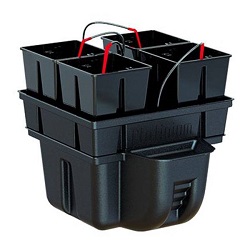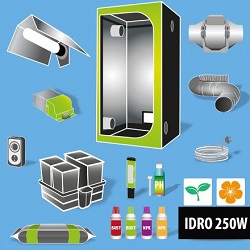The future of home cultivation? Without a doubt, the hydroponic garden, a revolutionary solution that allows you to grow fresh plants and vegetables at home all year round.
This type of home garden is gaining increasing popularity among gardening enthusiasts with limited space because it offers the possibility of vertical cultivation on terraces and balconies, following the principles of hydroponic farming.

Forget the traditional idea of soil cultivation, embrace this alternative practice, and grow your plants in a recirculating water system enriched with essential nutrients. Among the advantages of this revolutionary technique are fast growth and significant water savings.
Although it may seem complex, creating a hydroponic garden at home is accessible to everyone, requiring only some care and passion. In fact, it is rapidly becoming an integral part of sustainable interior design.
This article will be your complete guide, providing all the knowledge and tools necessary to create your own home hydroponic garden. From space management to benefits and costs, you will discover how to turn even the smallest balcony into a sustainable production oasis, without depending on external climatic conditions.
Table of Contents
- What is a hydroponic garden?
- Advantages and disadvantages of an indoor garden
- What is the yield of a vertical hydroponic garden?
- DIY Hydroponic Garden: how to build it?
- What are the best plants for hydroponics?
- How much does it cost to set up a hydroponic garden?
- Home garden kits: buy the necessary accessories at Grow Shop Italia
Before proceeding, also read: "DIY Hydroponics, how to build a hydroponic system".
What is a hydroponic garden?
A hydroponic garden introduces a revolutionary approach to growing plants without the use of traditional soil. In this indoor cultivation method, soil is replaced by substrates such as coconut fiber, perlite, expanded clay, rock wool, zeolite, or vermiculite, creating a controlled environment where plants thrive thanks to nutrient-rich solutions.
But what exactly is a hydroponic garden, and how does it work?
The term comes from the Greek "údor" (water) and "pónos" (work), indicating the art of growing plants in water. This ancient technique, dating back to the Hanging Gardens of Babylon and the Nile floods that fertilized surrounding fields, has been adapted to modern needs.
This garden abandons the idea of soil cultivation, opting instead for
inert and sterile substrates that support the roots of the cultivated plants. These roots are directly immersed in a mixture of water and nutrients.
This cultivation method is ideal for those with limited space, such as balconies, or those wanting to create vertical gardens. As we will see, hydroponic gardens use special containers or small-sized rows with holes, where plants are placed in expanded clay, rock wool, or perlite, providing root support while fully immersed in water.
What makes it truly unique is its recirculating water system, keeping water in constant motion and providing plants with all the nutrients needed for growth.
But why was this approach developed? The answer lies in the limitations of traditional soil cultivation, where plants with extensive roots require large spaces.
In small spaces, growing in pots or open soil becomes impractical. Hydroponic horticulture offers a technological solution to this challenge, allowing plants to grow without extended roots, as they receive all their nutrients dissolved in water.

Managing it requires careful attention, but the benefits are many. Let's explore them in the next section.
Advantages and disadvantages of an indoor garden
Hydroponic gardens offer many advantages, but also some challenges. In some ways, a hydroponic garden is much more technical and complex than traditional ones.
It is often developed vertically. A vertical hydroponic tower is as far from a traditional garden as possible. Yet, there are many reasons to choose this approach:
- Space optimization: a hydroponic garden in a city with no soil or with limited outdoor space allows for more plants by utilizing vertical surfaces instead of horizontal ground, maximizing space usage;
- Ease of management: the vertical arrangement is ideal for small balconies, simplifying access to plants and making sowing, harvesting, and maintenance easier. The garden is also easy to move, as these structures are usually lightweight and compact;
- Lower water consumption: the recirculating water system not only improves plant oxygenation and nutrient recovery but also eliminates the need for continuous watering unless the cultivated plants require misting on their leaves;
- Faster growth: since plant roots have direct access to a solution with all necessary nutrients, they do not waste energy searching for food in the soil, leading to faster and stronger growth;
- Healthier plants: using hydroponic solutions almost completely eliminates weeds and certain insects and parasites that can harm plants;
- Greater control: The hydroponic garden allows you to precisely control the nutrients you provide to your plants. Without deficiencies or toxic elements, you will achieve superior quality harvests.

Platinium HydroStar 40 Hydroponic System
Platinium HydroStar 40 with 4 pots of 3.4L, a small-sized hydroponic system with a drip irrigation system and a 20L reservoir.
Despite its numerous advantages, the hydroponic garden also has some disadvantages. Let's analyze the potential challenges to ensure a complete understanding before embarking on this journey:
- Commitment and active involvement: Managing a hydroponic system requires constant attention, as nutrients must be periodically dissolved in water and fertilization schedules must be adhered to. This highlights the need for continuous involvement from the grower;
- Plant dependency: Unlike soil cultivation, plants in a hydroponic system rely more on the structure that houses them. While soil-grown plants adapt to their environment, hydroponic plants can be negatively affected by imbalances in water composition or system malfunctions. This underscores the necessity of constant monitoring and timely intervention;
- Humidity sensitivity: Due to the constant presence of water, some plants sensitive to humidity or lacking defenses against fungi may not thrive in this environment. It is essential to select plants suitable for hydroponics and take preventive measures against humidity-related issues;
- Initial investment: Setting up a water-based garden can involve higher initial costs compared to traditional methods. However, these investments often pay off over time through savings and long-term benefits. This highlights the importance of carefully evaluating initial costs in relation to overall advantages.
Given these disadvantages, how productive is a hydroponic garden at home? Find out in the next section.
What is the yield of a vertical hydroponic garden?
The productivity of a vertical garden using hydroponic techniques can vary based on several factors, including:
- System size;
- Types of crops;
- Proper garden management;
- Quality of nutrient solutions;
- Lighting provided to the plants.
In general, however, such a garden is designed to maximize space utilization and can offer a higher yield compared to traditional growing systems, especially in urban environments or limited spaces.
On average, it is estimated that a hydroponic garden yields 2 to 10 times more than soil cultivation. Overall productivity also depends on the plants chosen for cultivation. For example, aromatic herbs, lettuces, and some fast-growing vegetables can produce results more quickly than larger, slower-growing plants.
Proper maintenance of the garden is essential, including monitoring nutrient levels, water pH, proper lighting, and managing circulating water. Paying close attention to these details can significantly contribute to the overall yield of the system.

DIY Hydroponic Garden: how to build it?
If you want to try this soil-free gardening method, you can purchase one of the many home garden kits or create one yourself. However, you must understand the basic concepts of hydroponic gardening as well as the types of hydroponic systems most commonly used.
If you are a beginner or have space for only a small system, it is best to start with the easiest plants to grow using this method, those with shallow roots.
Let's start with the necessary tools. What are they?
- Waterproof growth containers;
- Inert substrates and/or support structures (e.g., rock wool cubes);
- Water pump to circulate the nutrient solution;
- Container for mixing and storing the nutrient solution;
- Supply tubing to connect the pump to the irrigation system;
- Timer to control irrigation cycles;
- Artificial lighting kit;
- Nutrient solution for the plants;
- pH and EC meter/test kit.
Setting up a hydroponic garden requires a series of precise steps to ensure the correct growth and development of plants.

Hydroponic Grow Box Kit
Hydroponic Grow Box Kit for growth and flowering. This kit includes everything needed to cultivate plants hydroponically.
At this point, all that remains is to monitor your garden. Daily, weekly, and monthly management includes tasks such as checking water levels, inspecting irrigation and drainage, refilling water, and adding fertilizer.
Hydroponic cultivation is suitable for both outdoor spaces, such as gardens, balconies, or terraces, and indoor environments, as long as there is a proper light source. Contrary to common perception, a hydroponic garden does not necessarily need to be vertical, although this can undoubtedly provide an aesthetically pleasing effect.
There are compact and affordable solutions for those who want to approach this technique, such as devices that can be placed on a desk or bookshelf, making hydroponic cultivation more accessible and suitable for limited spaces.
What are the best plants for hydroponics?
By choosing specific plants—ideal for hydroponic cultivation—you can achieve maximum yield from your crops. If you have decided to create a hydroponic garden within the four walls of your home, we recommend starting with:
Hydroponic farming is suitable for a wide range of plants, but some species thrive particularly well in hydroponic systems. The best plants for hydroponics are generally those with roots that adapt well to a soil-free environment and can benefit from a constant supply of nutrients directly from the water.

If you have decided to start a hydroponic garden at home, we recommend growing:
- Lettuce and leafy greens, such as spinach, chard, kale;
- Aromatic herbs, such as basil, parsley, celery, mint, thyme;
- Vegetables, especially cucumbers, tomatoes, and peppers;
- Strawberries;
- Beans;
- Edible flowers (e.g., violets, nasturtiums, and marigolds).
Before starting hydroponic cultivation, it is important to consider the specific needs of each plant, carefully regulate nutrient levels, and provide adequate lighting.
How much does it cost to set up a hydroponic garden?
Determining the cost of setting up a hydroponic garden is a complex process that depends on several key factors. The choice between a vertical or horizontal structure, the size of the growing area, and the type of plants desired significantly influence the overall investment.
For an amateur grower looking to start a small indoor hydroponic garden with a basic starter kit, the cost generally ranges between 200 and 400 euros. Naturally, if opting for a more advanced system with cutting-edge technologies in terms of lighting, grow boxes, and extractors, the cost can rise up to 1,000 euros.
Do you want a more precise estimate of the costs for setting up your indoor garden? Contact the Grow Shop Italia expert team, who can provide you with tailored details based on the specific needs of your setup.

Check out our guide to hydroponic cultivation
Home garden kits: buy the necessary accessories at Grow Shop Italia
The hydroponic garden offers a practical and sustainable way to grow fresh and abundant crops at home all year round, regardless of the season.
Are you ready to start your hydroponic gardening journey? Make your home garden a reality with the practical kits assembled by Grow Shop Italia. Our extensive experience in the growing world has allowed us to create complete, practical, and reliable kits equipped with all the necessary tools to set up an easy-to-manage indoor cultivation space.
Buy your hydroponic cultivation kit from Grow Shop Italia and experience the joys and satisfaction of home cultivation.